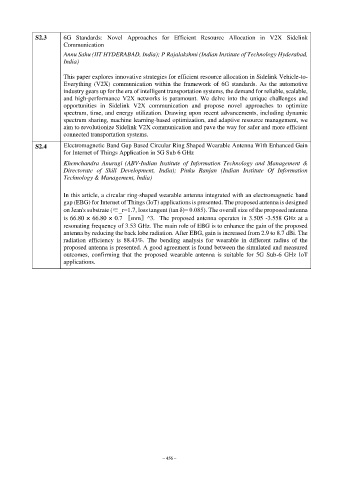Page 500 - Kaleidoscope Academic Conference Proceedings 2024
P. 500
S2.3 6G Standards: Novel Approaches for Efficient Resource Allocation in V2X Sidelink
Communication
Annu Sahu (IIT HYDERABAD, India); P Rajalakshmi (Indian Institute of Technology Hyderabad,
India)
This paper explores innovative strategies for efficient resource allocation in Sidelink Vehicle-to-
Everything (V2X) communication within the framework of 6G standards. As the automotive
industry gears up for the era of intelligent transportation systems, the demand for reliable, scalable,
and high-performance V2X networks is paramount. We delve into the unique challenges and
opportunities in Sidelink V2X communication and propose novel approaches to optimize
spectrum, time, and energy utilization. Drawing upon recent advancements, including dynamic
spectrum sharing, machine learning-based optimization, and adaptive resource management, we
aim to revolutionize Sidelink V2X communication and pave the way for safer and more efficient
connected transportation systems.
S2.4 Electromagnetic Band Gap Based Circular Ring Shaped Wearable Antenna With Enhanced Gain
for Internet of Things Application in 5G Sub 6 GHz
Khemchandra Anuragi (ABV-Indian Institute of Information Technology and Management &
Directorate of Skill Development, India); Pinku Ranjan (Indian Institute Of Information
Technology & Management, India)
In this article, a circular ring-shaped wearable antenna integrated with an electromagnetic band
gap (EBG) for Internet of Things (IoT) applications is presented. The proposed antenna is designed
on Jean's substrate (∈_r=1.7, loss tangent (tan δ)= 0.085). The overall size of the proposed antenna
is 66.80 × 66.80 × 0.7 〖mm〗^3. The proposed antenna operates in 3.505 -3.558 GHz at a
resonating frequency of 3.53 GHz. The main role of EBG is to enhance the gain of the proposed
antenna by reducing the back lobe radiation. After EBG, gain is increased from 2.9 to 8.7 dBi. The
radiation efficiency is 88.43%. The bending analysis for wearable in different radius of the
proposed antenna is presented. A good agreement is found between the simulated and measured
outcomes, confirming that the proposed wearable antenna is suitable for 5G Sub-6 GHz IoT
applications.
– 456 –

